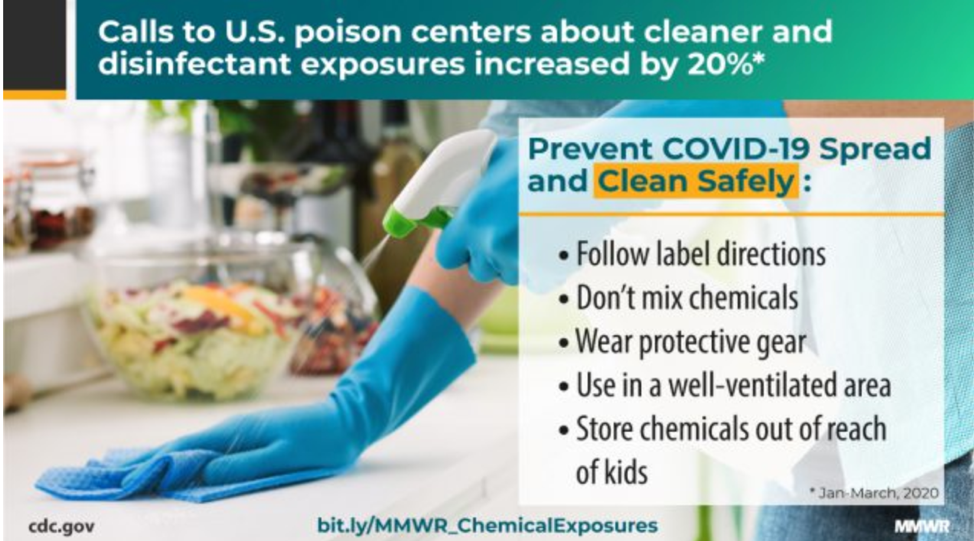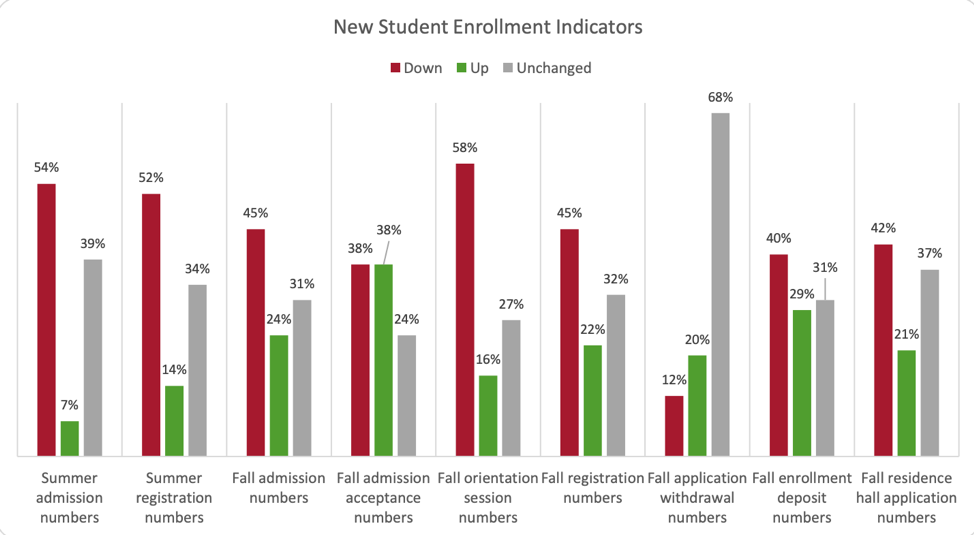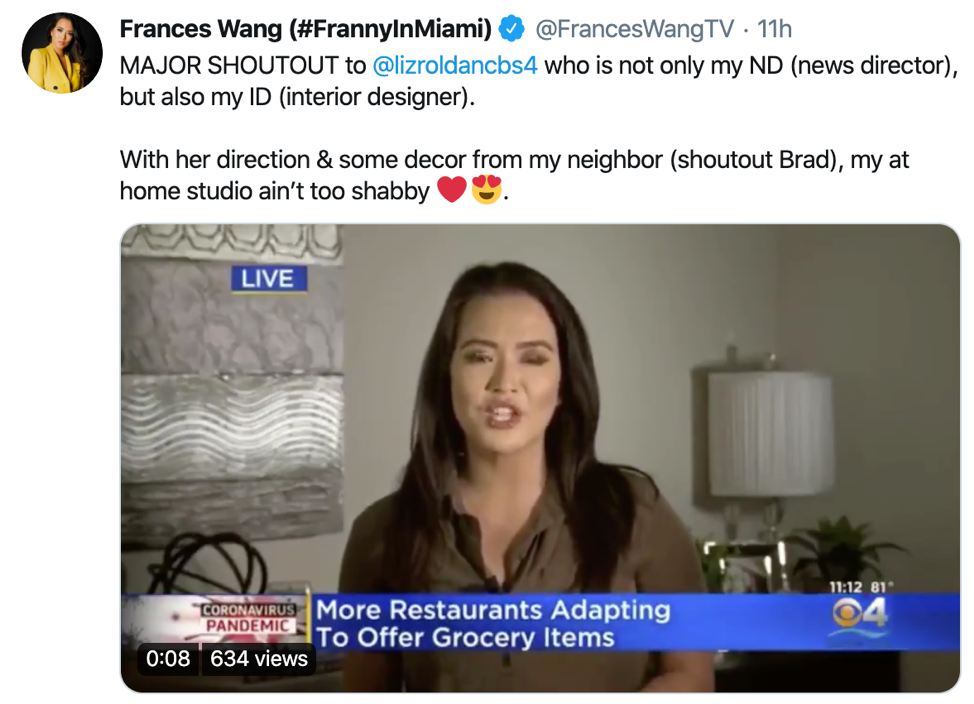 Covering COVID-19 is a daily Poynter briefing about journalism and coronavirus, written by senior faculty Al Tompkins. Sign up here to have it delivered to your inbox every weekday morning.
Covering COVID-19 is a daily Poynter briefing about journalism and coronavirus, written by senior faculty Al Tompkins. Sign up here to have it delivered to your inbox every weekday morning.
The rush to disinfect is poisoning us. Calls to poison control are way up.
Even before President Donald Trump mentioned that injecting sanitizers into humans could be worth studying, calls to poison centers were way up, according to the Centers for Disease Control and Prevention.
Calls increased even more after the president’s statement, NPR reported:
New York City says its poison control center received a higher-than-normal number of calls in the day after President Trump speculated that injecting household disinfectants could be a coronavirus treatment.
The city’s Department of Health and Mental Hygiene said that in an 18-hour period ending at 3 p.m. Friday, the poison control center recorded 30 cases. These included nine “specifically about exposure to Lysol, 10 cases specifically about bleach and 11 cases about exposures to other household cleaners,” department spokesperson Pedro F. Frisneda tells NPR. That compares with only 13 cases for the same time frame one year ago.
Some of the problems came from the misuse of disinfectants, some came from people believing internet nonsense and some came from children ingesting toxic stuff.
The CDC compared calls from the same time periods in 2019 and 2020 and found, “The daily number of calls to poison centers increased sharply at the beginning of March 2020 for exposures to both cleaners and disinfectants.”
The report said the largest percentage of calls involved children under the age of 5. The biggest increase in calls involved bleach and hand sanitizers. Most of the calls involved inhalation, not ingestion.
The CDC told of one case involving a person who was soaking her just-purchased produce when she was overcome by the fumes from a mixture of 10% bleach, vinegar and hot water. Bleaching your food is overdoing it — the CDC said there is no evidence that COVID-19 is transmitted from food to humans.
In a second case, a preschooler apparently drank alcohol-based hand sanitizer and was hospitalized for a couple of days.
The CDC said no doubt the cases it documented are an underestimate of the total number of exposures since COVID-19 spread because this study only counted calls to poison centers, and does not include emergency room visits, urgent care center treatments or family doctor visits.
By the way, I found this story by reading The Morbidity and Mortality Weekly Report, which is a good place to find front-edge studies.
Look, this is serious stuff. In Iran, as people got more frightened by the spreading virus, they started falling for dangerous remedies. Iranian media reported 300 people died and at least a thousand more were sickened after drinking methanol based on a rumor that it would cure or prevent the virus. The Associated Press has the story of a young boy who was blinded by the concoction, which was given to him by his parents.
Writers battle the National Emergency (virtual) Library
A few weeks ago, the Internet Archive announced it would launch a “National Emergency Library,” which it described as “a collection of books that supports emergency remote teaching, research activities, independent scholarship, and intellectual stimulation while universities, schools, training centers, and libraries are closed.”
The National Emergency Library upped its game last week, announcing it would suspend waitlists for nearly 1.5 million books. Now, copies can be checked out by an unlimited number of borrowers at the same time.
Over the weekend, authors started speaking up, calling it legal piracy. The Author’s Guild released a statement that said writers are struggling more than usual right now because of the loss of book tours and speaking engagements that supplement book sales.
The Author’s Guild wrote:
And now they are supposed to swallow this new pill, which robs them of their rights to introduce their books to digital formats as many hundreds of midlist authors do when their books go out of print, and which all but guarantees that author incomes and publisher revenues will decline even further.
Internet Archive is using a global crisis to advance a copyright ideology that violates current federal law and hurts most authors. It has misrepresented the nature and legality of the project through a deceptive publicity campaign. Despite giving off the impression that it is expanding access to older and public domain books, a large proportion of the books on Open Library are in fact recent in-copyright books that publishers and authors rely on for critical revenue. Acting as a piracy site — of which there already are too many — the Internet Archive tramples on authors’ rights by giving away their books to the world.
The Internet Archive pushed back:
This is a tremendous and historic outage. According to IMLS FY17 Public Libraries survey (the last fiscal year for which data is publicly available), in FY17 there were more than 716 million physical books in US public libraries. Using the same data, which shows a 2-3% decline in collection holdings per year, we can estimate that public libraries have approximately 650 million books on their shelves in 2020. Right now, today, there are 650 million books that tax-paying citizens have paid to access that are sitting on shelves in closed libraries, inaccessible to them. And that’s just in public libraries.
And so, to meet this unprecedented need at a scale never before seen, we suspended waitlists on our lending collection. As we anticipated, critics including the Authors Guild and the Association of American Publishers have released statements (here and here) condemning the National Emergency Library and the Internet Archive. Both statements contain falsehoods that are being spread widely online. To counter the misinformation, we are addressing the most egregious points here and have also updated our FAQs.
One of the statements suggests you’ve acquired your books illegally. Is that true?
No. The books in the National Emergency Library have been acquired through purchase or donation, just like a traditional library. The Internet Archive preserves and digitizes the books it owns and makes those scans available for users to borrow online, normally one at a time. That borrowing threshold has been suspended through June 30, 2020, or the end of the US national emergency.Is the Internet Archive a library?
Yes. The Internet Archive is a 501(c)(3) non-profit public charity and is recognized as a library by the government.What is the legal basis for Internet Archive’s digital lending during normal times?
The concept and practice of controlled digital lending (CDL) has been around for about a decade. It is a lend-like-print system where the library loans out a digital version of a book it owns to one reader at a time, using the same technical protections that publishers use to prevent further redistribution. The legal doctrine underlying this system is fair use, as explained in the Position Statement on Controlled Digital Lending.Does CDL violate federal law? What about appellate rulings?
No, and many copyright experts agree. CDL relies on a set of careful controls that are designed to mimic the traditional lending model of libraries.
I should note that the first edition of my book “Aim for the Heart” is included in the Internet Archive’s free cache. It was published in 2002 and is a bit out of date (I recently published the third edition). I am just fine with the older, out-of-print book being available free if it helps some journalism student somewhere.
But, on a personal note, as a writer, I feel the pain of these authors. Just because they want to be compensated does not mean they are anti-reading. The biggest issue is the Internet Archive suspending the waitlist for books, which means an unlimited number of free versions of a book can circulate.
And the Internet Archive’s argument that taxpayers have paid to access books at the library but can’t access them does not, to me, mean the books are now fair game to copy and distribute. The libraries also allow the downloading of current hit movies and music. Like the free books, when checking out movies (usually documentary/education films) and music there are limits to how many you can download per week and how long they last before digitally evaporating. The most popular library music program is Freegal, which is short for “free and legal.”
There are a few ways journalists can adapt this story. One is from the authors’ point of view and how they are trying to keep the rent checks coming in. The other is to do a story that focuses more on how to score free books, movies and music from public libraries and the Internet Archive.
Libraries are showing what valuable resources they are right now
Virtual book lending has spiked in recent weeks. And libraries are an important source of internet access for people who have none. The American Library Association said, “With more than 20 million people lacking home broadband access, public libraries are often the only source of free access to computers and the internet — hosting nearly 258 million computer sessions in one year.”
What happens if hurricane season overlaps with the pandemic?
This may fall under the category of “oh heck, I had not thought of that.” We are a little more than a month away from the June 1 start of the hurricane season and emergency planners have started thinking through what will happen if a hurricane hits and we are still in some version of stay-at-home mode.
Jared Moskowitz, director of Florida’s Division of Emergency Management, is raising the possibility, as he is planning what will happen if there is a storm evacuation and people cannot safely gather by the dozens or hundreds in gyms or convention centers. WFOR-TV in Miami reported:
In shelters, the state would need to provide people with masks and other protective gear and monitor people’s temperatures if the deadly respiratory disease is still around, he said.
“Doing all of those things doesn’t mean COVID-19 still couldn’t get into a mass shelter and then if you take somebody’s temperature and their temperature is high, do you divert them to a COVID-19-only shelter? Those are the things that we are examining,” Moskowitz said.
Moskowitz said the state is in talks with the Federal Emergency Management Agency to see if it can turn on an assistance program for displaced disaster survivors before a storm makes landfall. The federal program would allow the state to put people in hotels with the help of federal funds.
“It would also be good to help the (hotel) industry out in the state,” he said.
Transportation to shelters is also a concern.
Moskowitz said the state might want to talk to ride-sharing companies like Uber to avoid congregating too many people in buses or shuttles to and from shelters.
Florida emergency planners wonder if volunteers would show up to help after a hurricane if we are still in the throes of a pandemic.
This is exactly the kind of story that might get people thinking about preparation, so we are not all rushing to buy Pop-Tarts, toilet paper and beer before a storm. In my house here in St. Petersburg, Florida, we are just emptying our 2019 storm food pantry and have started adding a little each week for the 2020 storm season. When people are on a tight budget, stockpiling any supplies in a hurry is overwhelming. But start putting a few essential supplies away every week now and, by storm season, you will be ready.
I wonder how the things you have learned by working remotely will come in handy this storm season. Now it could be possible to produce a newscast or post to a newsroom website while sitting in a storm shelter.
Will universities and colleges reopen in the fall?
My Poynter colleague Barbara Allen is tracking which schools have made decisions about how they will hold classes in the fall. She reported:
Cal State Fullerton and San Jose State are planning for a fall semester remotely, Purdue and Mizzou are planning in-person, on-campus classes; Harvard and Boston are considering fall semesters that start in January, whereas Texas, Yale and George Washington will announce firm plans in the coming weeks.
The sobering reality is starting to settle in. A poll of the American Association of Collegiate Registrars and Admissions Officers found:
58% are considering or have already decided to remain fully online for fall 2020
62% are considering decreasing, or have decreased, the number of in-person courses for fall 2020
73% are considering increasing, or have increased, the number of online and/or remote courses for fall 2020
Now, let’s be clear, there is a significant difference between “considering” and “already decided” to remain fully online.
For universities, the fall semester is not a long way off — it is already here. Schools have to know what classes they will offer, who will teach those classes and how many students will need housing, and schools are making decisions on who they will accept for enrollment.
Here is more data from the AACRAO survey showing a lot of students are sitting on the sidelines right now. Summer enrollment is down at half of the schools, and 45% said fall enrollment is down from last year.
A Cornell working paper released on April 11 found that campuses are “small world” networks, with lots of interaction among students in close quarters. How much? At Cornell, the average student sits in classes with more than 500 other students per week. “The average student can ‘reach’ only about 4% of other students by virtue of sharing a course together, but 87% of students can reach each other in two steps, via a shared classmate,” according to Cornell sociologist Kim Weeden, co-author of the working paper. “By three steps, it’s 98%.”
No institution will want its dorms to be the next facility with close living arrangements — like cruise ships, nursing homes and prisons — to experience a serious outbreak.
“The idea that we will have the traditional fall opening is probably fantasy,” said (Brian A.) Sponsler, of the Education Commission of the States.
If campuses don’t reopen, a lot of students will decide it’s a good time for a gap year. No one wants to pay $60,000 to take Zoom classes. Enrollment declines will be steep, but will vary by region, said Mildred García, president of the American Association of State Colleges and Universities.
USA Today said some schools, usually smaller schools that can make institutional changes faster than big schools, are considering new ways of combining in-person and remote teaching.
A handful of colleges considered delaying the start of the fall semester or shortening it.
Utah State University’s president told students and employees classes might be smaller, and she expects “people will come back on campus but not in large, free-moving ways that we used to have,” according to The Herald Journal.
Changes are already in place at Beloit College in Wisconsin. The semester will start later than normal, and students will not take a traditional four-course semester, said Eric Boynton, provost and dean of the college.
Instead, the semester will be split in half: Students will take two more intensive courses in the first seven weeks and two more after that.
Inside Higher Ed laid out a range of 15 possible ways that schools could handle the fall semester. On the extremes are “everything goes virtual” and “we will do business as normal.” But other options I had not considered until reading this were: seniors only on campus, graduate students only on campus, freshmen only on campus (to give freshmen a strong start to college), and start online and finish the semester in-person. Yet another option includes a structured gap-year, where students take the semester to work on an intensive project or study.
The psychology behind the ‘pandemic makeover’
This weekend brought out our collective weirdness combined with boredom. People were all over social media cutting off their hair, dreaming of post-pandemic piercings and growing lumberjack beards.
Day 5 of my wild and untamed face. Please don’t put your hands near the cage. pic.twitter.com/gNcbnkiY54
— Jim Carrey (@JimCarrey) March 28, 2020
It turns out, there are psychological reasons humans turn to such things in stressful times. A story in Wired reported:
According to Christopher Oldstone-Moore, who studies gender and hair at Wright State University, beards are associated with warriors in ancient and medieval times, and, you know, manliness. At times like these, growing one can be a show of resilience. “Psychologically, it can be a sort of declaration of fortitude and heartiness,” he says. “It’s a way of saying, ‘I’m tough. I can withstand adversity.’” Makeover elements that require suffering actual physical pain, like piercings and tattoos, may be serving a similar function: thumbing your nose at a trying time just to remind yourself and others that you can.
The way we work now
I am not the least bit surprised at my friend Liz Roldan has an eye for set design as well as a nose for news.
Send me photos of the innovative ways you are working. Inspire us with cheap ingenuity. My new home desk, tucked away in my home studio (kid’s bedroom) is my wife’s grandmother’s sewing machine cabinet.
We’ll be back tomorrow with a new edition of Covering COVID-19. Sign up here to get it delivered right to your inbox.
Al Tompkins is senior faculty at Poynter. He can be reached at atompkins@poynter.org or on Twitter, @atompkins.










